1. Where to Stay
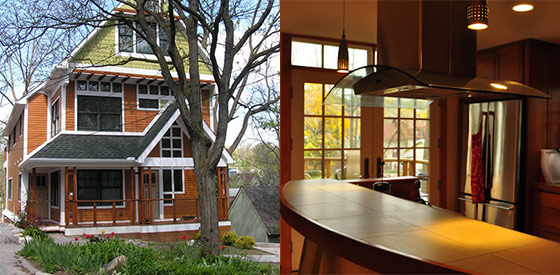
Experience architecture firsthand at Baxter House Bed & Breakfast (from $115), located just five blocks from downtown in the historic Kerrytown district. The three-story home blends an eclectic mix of craftsman, Victorian, and modern styles in its design, and multiple outdoor decks provide plenty of room for enjoying fresh air and soaking in the springtime sunshine. Opt for the third-floor Sunset Room (from $115), which includes a private deck and a soaking tub large enough for two. Innkeeper and cookbook author Kathleen Baxter prepares a delicious breakfast daily, with signature dishes like raspberry soup, homemade granola, and mixed grain scones.
Live like the movie version of a “starving artist” at this charming second-floor walk-up on Liberty Street (from $200). High ceilings open up the bohemian space while luxe silk curtains and brilliant, jewel-toned touches keep things cozy. The spot is nestled in the heart of Ann Arbor’s downtown, where sidewalk cafés, bars, and shops off South Main bustle in spring weather. Plenty of artwork graces the tall walls, but you’re also in walking distance of the WSG Gallery featuring contemporary works by local artists, Clay Gallery, and Ann Arbor Art Center.
Discover art in every cubby and corner at this early-20th-century home in the historic Old West Side (from $150) owned by a local artist. From a Chinese cabinet formerly used for housing chickens to hand-painted murals, the inventively decorated rental feels like a live-in curio cabinet of sorts (plus, it comes with a friendly resident cat). There’s also a patio garden enclosed within a honeysuckle-covered trellis. While you’ll likely spend more time perusing the owner’s collection of unique finds and personal works, the revered University of Michigan’s Museum of Art is just a mile away.
2. Where to Eat
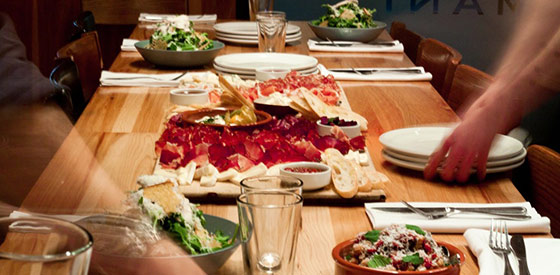
Sip a rare whiskey at the Ravens Club, where you can often find single bottles of spirits long forgotten by the general public, such as 20-year-old Barterhouse and Old Blowhard (26 years) by Orphan Barrel Whiskey. A rotating selection of seasonal craft beers and classic gastropub food like rabbit potpie ($12) and a burger made with locally raised, grass-fed beef from Steinhauser Farms ($14) are balanced by an impressive selection of bourbon and inventive menu items like the smoked-salmon tostada with beet salsa ($9) and grilled-watermelon salad served with avocado crème and pistachios ($8). Start with a few picks from the charcuterie menu—like the finocchiona, a Tuscan-style salami made with wild fennel seed and aged for 90 days ($6), or the earthy tartufo with black summer truffles ($6)—and add on a couple of local artisanal cheeses, such as Grassfields’ Fait Gras, an especially creamy cheddar ($6).
Grab a seat at the bar and order an Italian-inspired cocktail at the sleek but casual Mani Osteria. White subway tiles and simple wooden tables in the dining room make for a refined space that buzzes on weekends. Start with a perfectly crafted negroni ($9) or the refreshing Dolce Vida, prepared with house-made limoncello, watermelon, and Prosecco ($9) before sampling a few of the wood-fired pizzas; the Polpete, a thin-crust pie with meatballs, fresh ricotta, mint, and pickled chile is especially good ($15). Order some antipasti like the charred octopus, perfectly grilled and garnished with paper-thin crispy lemon slices and spicy arugula ($12), or the pickled tomatoes topped with velvety whipped ricotta and briny tapenade ($10). Move on to a plate of handmade pillowy gnocchi paired with seasonally changing ingredients like succulent braised veal and castelvetrano olives ($17), or tomatoes, ricotta, and mint ($15).
Feast on seasonal fare at Grange, where more than 90 percent of the ingredients are sustainably sourced from local farms. The white linens, wood accents, exposed brick, and chalkboard menu may look typically farm-to-table, but the jovial, welcoming service is pure midwestern charm. Order the tasting menu ($55 per person, $25 for table beverage pairings), likely to include local, otherwise-humble ingredients prepared with an elegant touch—think brioche-crusted walleye with mushroom ragout ($29), braised heritage pork served with house-made cotechino sausage and fennel broth ($27), and thoughtful garnishes like tangy pickled carrots or kimchi from Ann Arbor fermenter the Brinery. Be sure to stop by the weekday happy hour (from 5 to 7 p.m. Monday through Friday), when the offerings extend to signature craft cocktails like the Tea Thyme, a tart libation of black currant tea and Plymouth gin sweetened with thyme syrup ($10), wines by the glass ($8 to $13.50), and the hearty bar snacks (duck confit poutine, $10) are $2 off.
3. What to Do
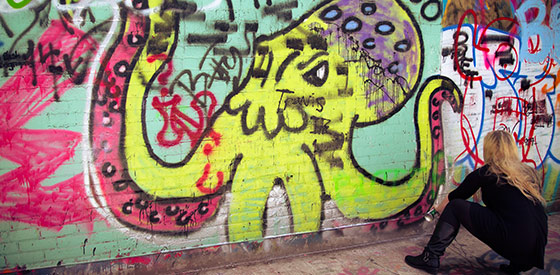
Catch a show at the Yellow Barn, a creative space for “community-supported culture.” Following the model of community-supported agriculture, members pay for a share of the organization and in return get free admission to all performances, film screenings, and art shows, as well as discounted classes. But you don’t need a membership (also called a Yellow Card) to get in on the action here. Monthly dance parties (second Saturdays) provide a great opportunity to get to know the arts community, and affordable exhibits and concerts (like the all-women art exhibition “Venus Rising,” opening May 16, or a jazz show featuring local and Balkan musicians, May 23) pop up regularly.
Tour Motawi Tileworks, where the American Arts and Crafts movement is alive and well. Founder and artist Nawal Motawi has a partnership with the Frank Lloyd Wright Foundation designing and fabricating tiles inspired by the architect’s forward-thinking, mid-century aesthetic. The Charley Harper collection, which features the modernist artist’s quintessential birds, is not to be missed. On the tour, check out the artisans as they mold, fire, and glaze the tiles by hand.
Take a walk down Graffiti Alley. Also known as Bubble Gum Alley or Poet’s Alley, the narrow walkway—literally off the beaten path behind Liberty Street—has a somewhat controversial history: While some Ann Arbor residents see it as a truly public place for artistic expression, others are turned off by the eccentric crowd congregating there daily. Graffiti started decking the walls here in the 1980s; then, in 1999, the city commissioned a mural symbolizing Ann Arbor’s art scene by artist Katherine Tombeau Cost, but freelance artists soon began adding their own work to it. In 2008, the mural was whitewashed by vandals, again creating a blank canvas open to anyone’s brush strokes. Give it a look now: While portions of Cost’s original mural are still visible, a tangle of overwhelming colors and lines now covers most of it.
4. Insider’s Tip
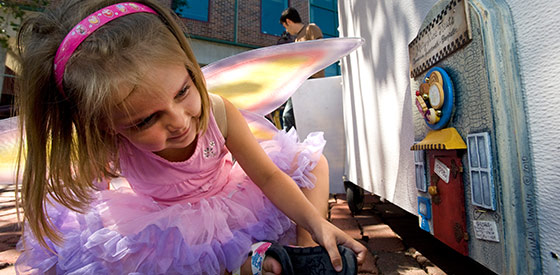
Some of the most surprising art in Ann Arbor is practically hidden in plain sight. Search for “fairy doors,” whimsical, miniature doors that began showing up scattered across town about ten years ago (the first one at Sweetwaters Coffee and Tea in 2005). No one knows who’s behind the pint-size entryways, but local “fairyologist” Jonathan B. Wright (he claims to have found several of the doors in his century-old home) has written several books and even created a helpful tour map for fellow fairy-seekers.
5. Oddball Day
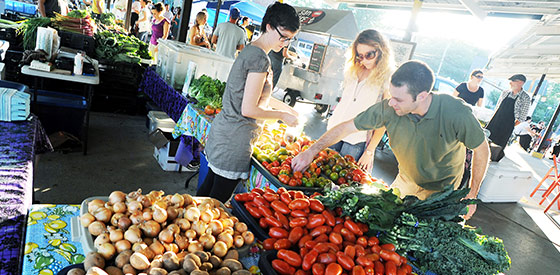
Take a break from artistic pursuits and get out in the crisp Michigan air. Start the day with the locals at Selma Café, a nonprofit monthly breakfast party prepared by local chefs to support sustainable agriculture in southeast Michigan. A $12 to $15 suggested donation gets you a top-notch breakfast that rivals the best brunch in town: Past meals have included everything from cumin-scented chickpeas with poached eggs, harissa, and North African spices to state-fair-inspired breakfast-sausage corn dogs. After breakfast, head over to the Ann Arbor Farmers Market in Kerrytown and stock up on provisions for a picnic lunch later: a chewy sourdough boule from Mill Pond, fresh or smoked mozzarella from Four Corners Creamery, and a luscious jam or fruit butter from Kern Road Farm. Make like a hearty Midwesterner and head out for a hike to Washtenaw County’s 35-mile Border-to-Border Trail, which runs straight through Ann Arbor’s Gallup Park. Follow the 3.25-mile paved walking trail, or rent a canoe at the livery for a paddle down the tranquil Huron River. Head back toward town and set up your picnic at the verdant Nichols Arboretum. Use the Washington Heights entrance for self-guided tour of the spectacular Peony Garden, at its peak in the spring with fat blooms of pink, ivory, and violet. Stick around for an evening of Shakespeare in the Arb (As You Like It is up most weekends in June), then clean up for a dinner alfresco back in town on the rooftop deck of Jolly Pumpkin Cafe and Brewery. The renowned sour beers here helped put Michigan on the craft-brew map; go for a glass of the crisp Bam Biere ($5), a farmhouse ale that pairs perfectly with the grass-fed JP burger ($13) or the mushroom torta topped with local White Lotus Farm goat cheese ($12). Take a post-dinner stroll through downtown toward Kerrytown and finish the day with a drink at the bar at 327 Braun Court, a tucked-away “upscale dive bar” with ridiculously well-priced experimental cocktails like the Old Cuban made with aged rum, cava, lemon, bitters, and mint ($9), and a dimly lit atmosphere that’s somewhere between too cool for school and just right.
6. Links
Find a map and a guide to Ann Arbor’s public art this homespun yet useful site, created by a University of Michigan student.
Ask the locals by consulting the Ann Arbor wiki, where residents regularly update listings on what to do in Ann Arbor.
Learn more about Ann Arbor’s female artists and when you can view their work on the blog of the Ann Arbor Women Artists.
Check the culture listings on eCurrent, the food, arts, and culture publication for Washtenaw County.